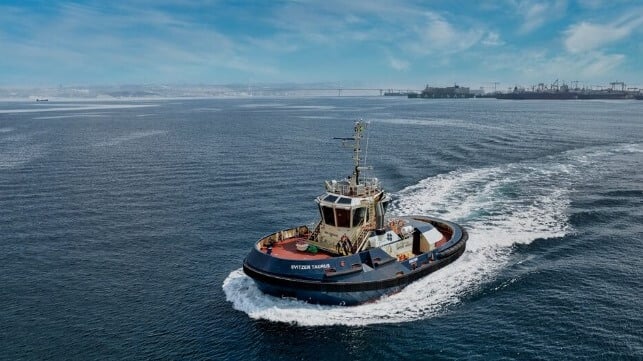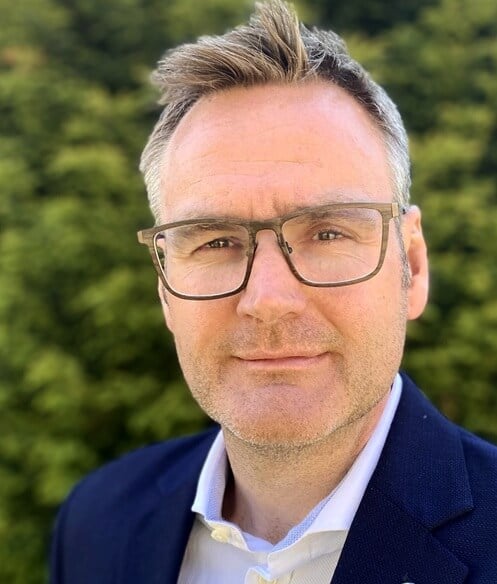To Decarbonize Towage, Svitzer Thinks Like a Startup

 Towage provider Svitzer is known for its global scale, but it's also making a name for itself in low-carbon towing. Together with customer Hoegh Autoliners, it recently rolled out its first very-low-carbon towing service, powered by carbon insetting from biofuel consumption across Svitzer's global fleet. To find out more about the ideas that power Svitzer's green transformation, TME spoke with head of decarbonization Gareth Prowse (left).
Towage provider Svitzer is known for its global scale, but it's also making a name for itself in low-carbon towing. Together with customer Hoegh Autoliners, it recently rolled out its first very-low-carbon towing service, powered by carbon insetting from biofuel consumption across Svitzer's global fleet. To find out more about the ideas that power Svitzer's green transformation, TME spoke with head of decarbonization Gareth Prowse (left).
TME: Could you tell us about your background and how you came to work in maritime decarbonization?
I started with a marine biology degree and a PhD in organic pesticides and ecotoxicology. Following that, I ended up in the coatings industry doing environmental and human risk assessment for marine paint products, particularly anti-fouling solutions. As my career progressed and corporate social responsibility and sustainability became more important, I focused on how coatings can drive emissions reduction in vessels.
Three years ago, I was fortunate enough to join Svitzer as head of decarbonization to set the strategy and direction of travel for our tug fleet. For years I was around the industry looking in, and it's been great to be inside the industry looking out for a change.
What does it take to reduce emissions across a fleet of 450 tugs worldwide?
So I think it's a bit of a hackneyed statement these days, but it’s true that there's no silver bullet, no single solution that's really going to help you to achieve your goals when it comes to decarbonization. We need flexibility in our approach. We have to consider vessel age, equipment, operational profile, and regional limitations with respect to biofuel and shore power availability.
Our strategy operates across three key themes: behavior, equipment, and fuel. Solutions range from slower transit speeds to shortening transit distances to using drop-in biofuels. Each region has different macroeconomic drivers and regulatory frameworks, which influence available solutions. For example, biofuels are widely available in Europe but less so in Australia, so we need different solutions for different regions.
What's different about decarbonizing smaller vessels compared to large ships?
The scale is completely different. While large vessels might need hundreds or thousands of tons of fuel for a single bunkering, we might use just 40 tons of diesel every two weeks. With batteries and methanol, we might only need 100 tons of alternative fuel per year. This creates opportunities to work with suppliers who deal in smaller volumes that wouldn't be practical for large container ships.
But the challenges aren't necessarily easier - they're just different. We're caught in a gray area between large ship regulations and road transport solutions. For example, when people talk about ammonia as the future maritime fuel, that makes little sense for small vessels. We need solutions that fit our scale of operations and operational profiles. On top of that, scaling solutions across so many vessels is not without its challenges, and we don’t have a lot of space on board to accommodate some of the more cutting-edge options, like carbon capture systems.
Speaking of small-scaled solutions, can you tell us about the new Robert Allan / Svitzer TRAnsverse tug design?
Our TRAnsverse tug design completely rethinks traditional tug operations, and will be way more efficient than the standard vessel that you can buy today. Instead of focusing on static bollard pull - the absolute power a tug can deliver when stationary - we've arranged the thrusters differently, with one at the front and one at the rear in combination with a unique tow connection, allowing the vessel to generate higher dynamic pulls while using less power. This makes the vessel more capable and more efficient than standard tug designs. Tow tank data, CFD modeling and time spent in the simulator, indicate that we get double-digit reductions in fuel consumption relative to the current fleet. We’re now seeing the same results from the real data generated by Svitzer Taurus, the first TRAnsverse vessel to go into operation. Since the best liter of fuel is the liter you didn't use, we're super excited to see these operational results and really see what it can do.
This efficiency also makes it easier to implement battery power and other alternative fuel solutions where we may need to compromise on the energy density of the fuels we expect to use in the future. We're currently building a hybrid version, scheduled for service in Gothenburg in 2026. The vessel will be a fully electric platform, which will use battery power in combination with methanol range extenders to maximize the operational range of the vessel and ultimately the work it can carry out.
What changes are you making across the existing fleet to boost efficiency?
We're seeing benefits from several approaches. We have five vessels using the SYDRIVE systems, where we can connect both thrusters to one engine through a gearbox system, optimizing fuel consumption. We've been working with battery-enabled vessels for around 10 years now, and as we renew those batteries, we're moving from traditional lithium-ion to newer chemistries like lithium iron phosphate (LFP), which offer better energy density and discharge rates. This allows us to go from 500kw per vessel to 1.3 MW per vessel. This should have a dramatic effect on fuel used during operation and will help us to sharpen how we operate vessels with batteries to maximize fuel efficiency.ds
We see significant opportunities for battery vessels across our fleet, but it is crucial that we that we can get access to shoreside charging infrastructure. We have built significant experience working with biofuels, both HVO (Hydrotreated Vegetable Oil) and FAME (Fatty Acid Methyl Ester) at high blend levels (B80+) - that's a significant lever. And we can see methanol availability developing in the future. Essentially, it's about being ready to pull all of these levers in combination so we can make the most of them when they become available to us.
That said, we're not complacent about revisiting old challenges and old questions to see if we can do something different with available technologies, as well as the future stuff. We also need to make sure that it's sustainable in the way that we approach it, so we're always looking at the business case and which option is the lowest cost of abatement.
Charging is often a challenge for battery-electric vessels - how do you work with ports to enable charging infrastructure?
It's early days, but we're finding that partnership models are key. Many ports want to support decarbonization but face financial and infrastructure constraints of their own. What we see in some of our locations is that the local grid is poor, or there isn't much of it at all. Sometimes just getting enough shore power to keep the lights on is challenging, because the financing to develop port infrastructure isn't there.
Partnership models can help address the funding gap. We're seeing new companies emerge that will take on all the cost of installing shore-side equipment and then recover their costs through energy pricing, so everybody wins. That's one of the things that we've learned often - these things are not easy to solve on your own, but by talking with ports and figuring out what their pain points are, you can solve it together.
The challenge is that the tug sector is not as heavily regulated on emissions as larger vessels (over 5,000 gross tons), so there's less external pressure driving change. We're stuck in this gray area where the regulation doesn't drive the change, so investing comes with risk. Some of the solutions are expensive, and customers' willingness to pay for the cost difference is limited. This holds us back from progressing as fast as we may like, but we’re laying the groundwork for future opportunities when other stakeholders are ready to go.
What role does crew behavior play in reducing emissions?
Our "Aim for 8" program uses AIS tracking and machine learning to monitor vessel speeds and determine optimal speeds for different operations. While behavioral changes alone won't get us to our targets, they're crucial for change management. About 80% of our fuel is burned during the working phase, so we're particularly interested in optimizing operations during active towage. The program helps gamify fuel optimization and engages crews in finding solutions.
This engagement is especially important as we introduce new technologies like methanol-powered vessels and battery systems, which require new training and procedures. When crews understand why changes are necessary and see their role in the solution, they understand why we're asking them to do things differently.
More often than not, I find people are “on board” with decarbonization. They see it as important, and they want to drive the change. Mariners can be part of the solution. If you find a great idea and it works, we want to can scale that very quickly across 450 vessels - even if it isn’t all of them, we should be able to find enough to have an impact.
What lessons have you learned that might help other operators?
First, everyone needs to be aligned on looking for solutions and challenging existing practices. We use a pilot-scale-policy approach: test ideas on a small scale, and if they work, expand them. If it works on one tug, does it work on 10? If it works on 10, does it work on 20? And if it works everywhere, then you can just set it as a policy. This startup-style thinking helps us validate hypotheses about what works for our operations, customers, and ports.
I think you really need to have that explorer mindset - you should never underestimate or ignore the fact that at the end of the day, you're in a competitive market and you have to serve customers. Focus on opportunities that reduce operational costs while providing environmental benefits. If you can eliminate the "green premium," it's easier to make the business case for sustainability investments, so never lose sight of the return on investment - that CO2 reduction per dollar spent is really important.
